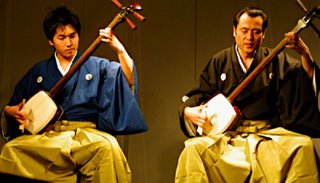
The Music of Toru Takemitsu by Peter Burt arrived from Amazon. In particular, the chapter “into the reflection of an Eastern mirror” considers his approach to November Steps for shakuhachi, biwa and orchestra and Autumn for the same combination a couple of years later. I will be looking at the ways in which Takemitsu tried to integrate Western instruments and an inherent tonality and techniques of orchestration with idiomatic writing for the traditional Japanese instruments. This coincides nicely with the DVD Kaoru Kakizakai sent me of his performance of November Steps performed with NHK Symphony Orchestra.
from Wikipedia:
Tōru Takemitsu (武満 徹 Takemitsu Tōru, October 8, 1930–February 20, 1996) was a Japanese composer of music, who explored the compositional principles of Western classical music and his native Japanese tradition both in isolation and in combination. Born in Tokyo, Takemitsu first became interested in western classical music around the time of World War II. He heard western music on American military radio while recuperating from a long illness. He also listened to jazz from his father's ample collection. Takemitsu was largely self-taught in music. He was greatly influenced by French music, and in particular that of Claude Debussy and Olivier Messiaen. In 1951 he founded the Jikken Kobo, a group which introduced many contemporary western composers to Japanese audiences. Takemitsu at first had little interest in traditional Japanese music, but later incorporated Japanese instruments such as the shakuhachi (a kind of bamboo flute) into the orchestra. November Steps (1967), a work for shakuhachi and biwa (a kind of Japanese lute) solo and orchestra was the first piece to combine instruments from east and west. In an Autumn Garden (1973-79) is written for the kind of orchestra that would have played gagaku (traditional Japanese court music). Works such as Eclipse, (1966) for shakuhachi and biwa, Voyage (1973), for three biwas should also been mentioned as works that are decidedly derived from traditional genres. Takemitsu first came to wide attention when his Requiem for string orchestra (1957) was accidentally heard and praised by Igor Stravinsky in 1959 (some Japanese people wanted Igor Stravinsky to hear some tape recorded music by Japanese composers and put in the wrong side of the tape - when they tried to take it out, Stravinsky didn't let them). Stravinsky went on to champion Takemitsu's work. Takemitsu's works include the orchestral piece A Flock Descends Into the Pentagonal Garden (1977), Riverrun for piano and orchestra (1984, the title is the first word in James Joyce's Finnegans Wake), and the string quartet A way a Lone (1981, another piece inspired by Finnegans Wake). He reworked his 1981 piece Toward the Sea (for flute and guitar) twice, once for flute, harp and string orchestra and later again for flute and harp. Chamber music such as Distance de Fee (1951) for violin and piano, or Between tides, for violin, cello and piano, are to be also mentioned. And such jewels of the piano music as Rain tree sketch (1982), Rain Tree Sketch II (1992), Les Yeux Clos (1979) and Les Yeux Clos II (1988) are considered to be amongst the finest works for the instrument written in the twentieth century. He also composed electronic music and almost a hundred film scores for Japanese films including those for Hiroshi Teshigahara's Woman in the Dunes (1964), Akira Kurosawa's Ran (1985) and Shohei Imamura's Black Rain (1989). His first score was for Toshio Matsumoto's Ginrin. His music for cinema rests deeply upon the concept that a new film needs a new sound colour, and is as much about taking out sounds as about taking them in. Some of the formal concepts in Takemitsu's music depend deeply on visual imagery, taken from paintings, dreams, or his concept (about which he writes much) of the garden. Takemitsu died in Tokyo on February 20, 1996. He was posthumously awarded the fourth Glenn Gould Prize in Autumn, 1996.
Further reading
• Peter Burt, The Music of Toru Takemitsu (Cambridge University Press, 2001)
• Noriko Ohtake, Creative sources for the Music of Toru Takemitsu (Ashgate, 1993)
• Toru Takemitsu, Confronting Silence (Fallen Leaf Press, 1995)
 Today I attended the first of my Japanese calligraphy classes at WEA, 5.30pm Wednesday afternoons. Our teacher is Michiko Honda and I joined after learning of the class from Kevin. She knows Riley Lee and Ben Dixon - what a small world.
Today I attended the first of my Japanese calligraphy classes at WEA, 5.30pm Wednesday afternoons. Our teacher is Michiko Honda and I joined after learning of the class from Kevin. She knows Riley Lee and Ben Dixon - what a small world.





